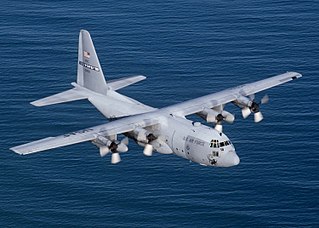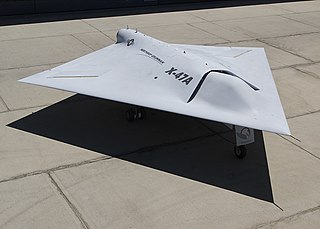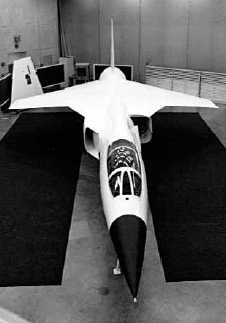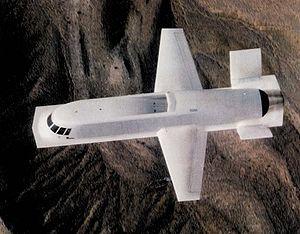
The Northrop B-2 Spirit, also known as the Stealth Bomber, is an American heavy strategic bomber, featuring low-observable stealth technology designed to penetrate dense anti-aircraft defenses. A subsonic flying wing with a crew of two, the plane was designed by Northrop as the prime contractor, with Boeing, Hughes, and Vought as principle subcontractors, and was produced from 1987 to 2000. The bomber can drop conventional and thermonuclear weapons, such as up to eighty 500-pound class (230 kg) Mk 82 JDAM GPS-guided bombs, or sixteen 2,400-pound (1,100 kg) B83 nuclear bombs. The B-2 is the only acknowledged in-service aircraft that can carry large air-to-surface standoff weapons in a stealth configuration.

The Lockheed C-130 Hercules is an American four-engine turboprop military transport aircraft designed and built by Lockheed. Capable of using unprepared runways for takeoffs and landings, the C-130 was originally designed as a troop, medevac, and cargo transport aircraft. The versatile airframe has found uses in other roles, including as a gunship (AC-130), for airborne assault, search and rescue, scientific research support, weather reconnaissance, aerial refueling, maritime patrol, and aerial firefighting. It is now the main tactical airlifter for many military forces worldwide. More than 40 variants of the Hercules, including civilian versions marketed as the Lockheed L-100, operate in more than 60 nations.

The Northrop Grumman E-8 Joint Surveillance Target Attack Radar System is a retired United States Air Force (USAF) airborne ground surveillance, battle management and command and control aircraft. It tracks ground vehicles and some aircraft, collects imagery, and relays tactical pictures to ground and air theater commanders. The aircraft was operated by both active duty USAF and Air National Guard units and also carried specially trained U.S. Army personnel as additional flight crew until its retirement in 2023.

The Lockheed F-117 Nighthawk is a retired American single-seat, subsonic twin-engine stealth attack aircraft developed by Lockheed's secretive Skunk Works division and operated by the United States Air Force (USAF). It was the first operational aircraft to be designed with stealth technology.

The RQ-3 DarkStar is an unmanned aerial vehicle (UAV). Its first flight was on March 29, 1996. The Department of Defense terminated DarkStar in January 1999, after determining the UAV was not aerodynamically stable and was not meeting cost and performance objectives.

The Northrop Grumman RQ-4 Global Hawk is a high-altitude, remotely-piloted surveillance aircraft introduced in 2001. It was initially designed by Ryan Aeronautical, and known as Tier II+ during development. The RQ-4 provides a broad overview and systematic surveillance using high-resolution synthetic aperture radar (SAR) and electro-optical/infrared (EO/IR) sensors with long loiter times over target areas.

The Lockheed Martin/Boeing F-22 Raptor is an American twin-engine all-weather stealth fighter aircraft developed and produced for the United States Air Force (USAF). As a product of the USAF's Advanced Tactical Fighter (ATF) program the aircraft was designed as an air superiority fighter, but also incorporates ground attack, electronic warfare, and signals intelligence capabilities. The prime contractor, Lockheed Martin, built most of the F-22's airframe and weapons systems and conducted final assembly, while program partner Boeing provided the wings, aft fuselage, avionics integration, and training systems.

The Northrop/McDonnell Douglas YF-23 is an American single-seat, twin-engine, supersonic stealth fighter aircraft technology demonstrator designed for the United States Air Force (USAF). The design team was a finalist in the USAF's Advanced Tactical Fighter (ATF) demonstration/validation competition, battling the YF-22 team for the full-scale development contract. Two YF-23 prototypes were built.

The Advanced Tactical Fighter (ATF) was a program undertaken by the United States Air Force to develop a next-generation air superiority fighter to counter emerging worldwide threats, including Soviet Sukhoi Su-27 and Mikoyan MiG-29 fighters under development in the 1980s, Beriev A-50 airborne warning and control system (AWACS), and increasingly sophisticated surface-to-air missile systems. Lockheed and Northrop were selected in 1986 to respectively develop the YF-22 and the YF-23 technology demonstrator aircraft for the program's demonstration and validation (Dem/Val) phase. These aircraft were evaluated in 1991 and the Lockheed team was selected for full-scale development, or Engineering and Manufacturing Development (EMD), and later developed the F-22 Raptor for production and operational service.

The Pratt & Whitney F119, company designation PW5000, is an afterburning turbofan engine developed by Pratt & Whitney for the Advanced Tactical Fighter (ATF) program, which resulted in the Lockheed Martin F-22 Raptor. The engine delivers thrust in the 35,000 lbf (156 kN) class and was designed for sustained supersonic flight without afterburners, or supercruise. Delivering almost 22% more thrust with 40% fewer parts than its F100 predecessor, the F119 allows the F-22 to achieve supercruise speeds of up to Mach 1.8. The F119's nozzles incorporate thrust vectoring that enable them to direct the engine thrust ±20° in the pitch axis to give the F-22 enhanced maneuverability.

The Northrop Grumman X-47 is a demonstration unmanned combat aerial vehicle. The X-47 began as part of DARPA's J-UCAS program, and is now part of the United States Navy's UCAS-D program to create a carrier-based unmanned aircraft. Unlike the Boeing X-45, initial Pegasus development was company-funded. The original vehicle carries the designation X-47A Pegasus, while the follow-on naval version is designated X-47B.
The Northrop Grumman E-10 MC2A was planned as a multi-role military aircraft to replace the Boeing 707-based E-3 Sentry and E-8 Joint STARS, the Boeing 747-based E-4B, and the RC-135 Rivet Joint aircraft in US military service. The E-10 was based on the Boeing 767-400ER commercial airplane.

The Lockheed/Boeing/General Dynamics YF-22 is an American single-seat, twin-engine fighter aircraft technology demonstrator designed for the United States Air Force (USAF). The design team was a finalist in the USAF's Advanced Tactical Fighter (ATF) competition, and two prototypes were built for the demonstration/validation phase of the competition. The YF-22 team won the contest against the YF-23 team for full-scale development, and the design was developed into the Lockheed Martin F-22. The YF-22 has a similar aerodynamic layout and configuration as the F-22, but with notable differences in the overall shaping such as the position and design of the cockpit, tail fins and wings, and in internal structural layout.
The Boeing Bird of Prey was a black project aircraft, intended to demonstrate stealth technology. It was developed by McDonnell Douglas and Boeing in the 1990s. The company provided $67 million of funding for the project; it was a low-cost program compared to many other programs of similar scale. It developed technology and materials which would later be used on Boeing's X-45 unmanned combat air vehicle. As an internal project, this aircraft was not given an X-plane designation. There are no public plans to make this a production aircraft. It is characterized as a technology demonstrator.

Lockheed Have Blue was the code name for Lockheed's proof of concept demonstrator for a stealth fighter. Have Blue was designed by Lockheed's Skunk Works division, and tested at Groom Lake, Nevada. The Have Blue was the first fixed-wing aircraft whose external shape was defined by radar engineering rather than by aerospace engineering. The aircraft's faceted shape was designed to deflect electromagnetic waves in directions other than that of the originating radar emitter, greatly reducing its radar cross-section.

The Lockheed CL-1200 Lancer was a late 1960s company-funded proposal for a fighter aircraft based on the Lockheed F-104 Starfighter. The CL-1200 was conceived and marketed mainly for and to non-US military services, as an export product. As such it would have competed with combat-proven designs like the Dassault Mirage III, McDonnell Douglas F-4 Phantom II, Mikoyan-Gurevich MiG-21, and Northrop F-5E Tiger II. The CL-1200 competed unsuccessfully against proposed fourth generation designs, under the US government's Lightweight Fighter program, which would eventually result in the General Dynamics F-16 and Northrop F-17 Cobra.

The General Electric YF120, internally designated as GE37, was a variable cycle afterburning turbofan engine designed by General Electric Aircraft Engines in the late 1980s and early 1990s for the United States Air Force's Advanced Tactical Fighter (ATF) program. It was designed to produce maximum thrust in the 35,000 lbf (156 kN) class. Prototype engines were installed in the two competing technology demonstrator aircraft, the Lockheed YF-22 and Northrop YF-23.
The Lockheed Senior Prom was a classified black project conducted by the United States Air Force in conjunction with the Lockheed Corporation's Skunk Works for the development and testing of a cruise missile using stealth technology. Based on the company's Have Blue demonstrator, the six Senior Prom vehicles proved successful in testing conducted at Area 51 in the late 1970s; despite this, the aircraft was not selected to enter production, and the program was terminated in the early 1980s.

The Mitsubishi X-2 Shinshin is a Japanese experimental aircraft for testing advanced stealth fighter aircraft technologies. It is being developed by the Japanese Ministry of Defense Technical Research and Development Institute (TRDI) for research purposes. The main contractor of the project is Mitsubishi Heavy Industries. Many consider this aircraft to be Japan's first domestically made stealth fighter. ATD-X is an abbreviation for "Advanced Technology Demonstrator – X". The aircraft is widely known in Japan as Shinshin although the name itself is an early code name within the Japan Self-Defense Forces and is not officially in use. The aircraft's first flight was on 22 April 2016.

Richard G. Thomas was an American test pilot, who flew the Tacit Blue, and several spin tests on the F-5F program, including the first flights on both aircraft for the Northrop Corporation.




















